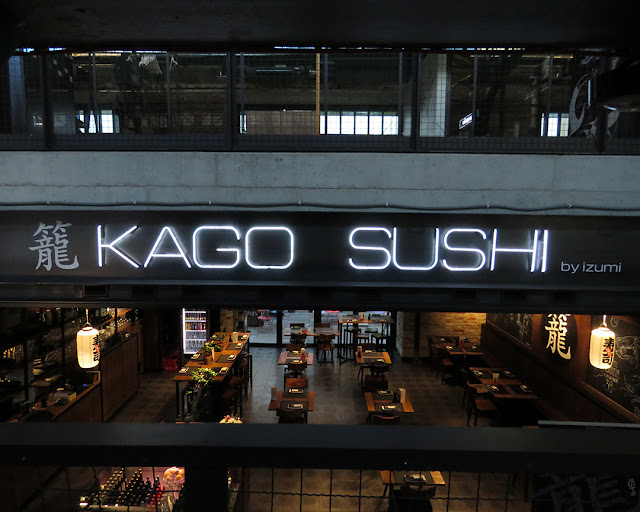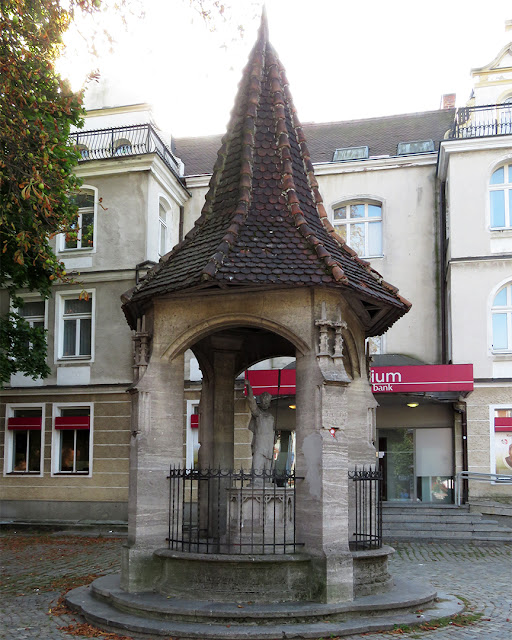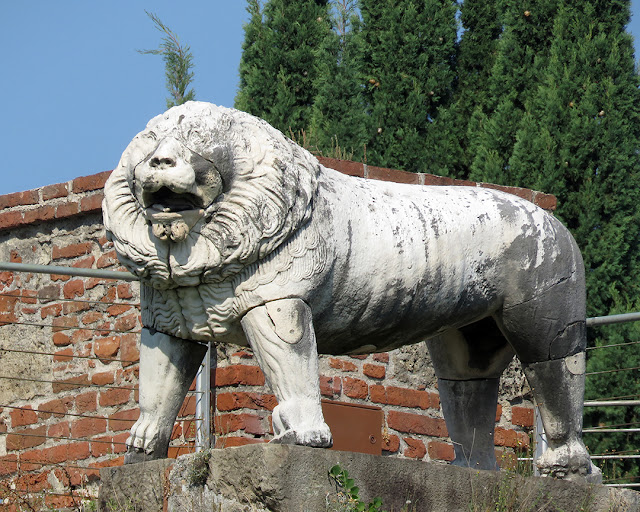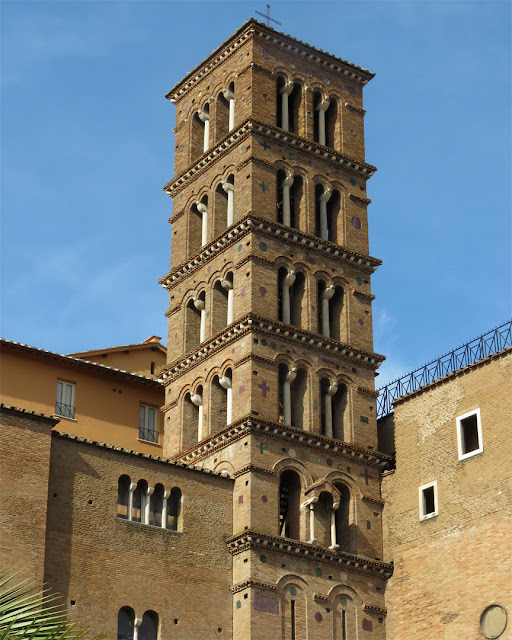Monday, January 31, 2022
New Pendolino
Express InterCity Premium (ED250 New Pendolino)
Gdynia Główna
plac Konstytucji
Gdynia, September 2018
“The New Pendolino is a class of high-speed tilting trains built by Alstom Ferroviaria (Fiat Ferroviaria) for Trenitalia and Cisalpino customers, derived from a model developed at the time for the Chinese operator Changchun Railway Company and subsequently developed for other railway companies, using or not the variable weight technology that characterizes this family of rolling stock.” (New Pendolino, Wikipedia)
Sunday, January 30, 2022
Saturday, January 29, 2022
Painting and piano
“Cosmosi” by Pablo Echaurren
Auditorium Parco della Musica
Via de Coubertin
Rome, September 2019
“Pablo Echaurren (Rome, 22 January 1951) is an Italian painter, comics artist and writer. He is the son of Chilean surrealist painter Roberto Matta and Italian actress Angela Faranda. His surname stems from a clerical error in the civil registry office, which was eventually corrected, but Echaurren continued to use the name professionally. Despite being Roberto Matta's son, Gianfranco Baruchello was Echaurren’s real art mentor. Baruchello introduced him to Arturo Schwarz who became his first manager. Since the early 1970s, Echaurren has exhibited his work in Italy and abroad. In the 1980s and 1990s he produced numerous avant-garde comics such as Caffeina d’Europa (a work devoted to Marinetti’s life, and one of his first graphic novels), Majakovskij, Nivola vola, Futurismo contro, Vita disegnata di Dino Campana, Evola in Dada, Vita di Pound, Dada con le zecche.” (Pablo Echaurren, Wikipedia)
Friday, January 28, 2022
Kago Sushi
Kago Sushi
Hala Koszyki (Koszyki Hall)
ulica Koszykowa
Warsaw, September 2018
“Hala Koszyki was purchased in 2009 by Avestus Real Estate which hoped to revitalize the object. It was subsequently demolished, with the exception of the two side wings and the northern wall of the arcade facing Koszykowa Street. Its complete redevelopment and reconstruction began after Griffin Group purchased the site in 2012. The market hall was redesigned by JEMS Architekci and reopened in October 2016. All of the original structural elements were reincorporated into the new mixed-use building. The venue inside offers restaurants specializing in haute cuisine, bars, pubs, cafeterias, bookstores and designer shops.” (Hala Koszyki, Wikipedia)
Thursday, January 27, 2022
Artillery House
Ceramic miniature howitzer
Artillery House
Artillery Row, Westminster
London, September 2014
“The doorways are each surmounted by a ceramic miniature howitzer, appropriate to the building's name, with strip windows lighting stairs above. The 5 centre bays have their metal framed casement groups recessed between tapered, receding ‘streamlined’ buttresses. Heavy projecting cornice on paired brackets; set back attic. The whole is very little altered.” (Artillery House, British Listed Buildings)
Wednesday, January 26, 2022
Tuesday, January 25, 2022
Kamienica Pod Pająkiem
Kamienica Pod Pająkiem (House under the Spider) by Teodor Talowski, 1889
ulica Karmelicka
Kraków, September 2018
Monday, January 24, 2022
Personnage
“Personnage” by Joan Miró, 1970
Joan Miró Foundation
Jardins de Laribal, Montjuïc
Barcelona, March 2017
Sunday, January 23, 2022
Ad tenendam propositam spem
“Ad tenendam propositam spem” (Let us hold fast the confession of our hope)
(From the ‘Epistle to the Hebrews’)
Santa Croce in Via Flaminia
Via Guido Reni
Rome, September 2019
“Santa Croce in Via Flaminia is a basilica church dedicated to the Holy Cross on the Via Flaminia in Rome, Italy. Sacred Military Constantinian Order of Saint-George has its seat there.It was first built in 1913 by the architect Aristide Leonori for Pope Pius X, in celebration of the 1600th anniversary of the Edict of Milan. In the style of a Roman basilica, it has a mosaic-decorated facade, a portico with six Doric columns and a mosaic by Biagio Biagetti, a five-storey bell tower and a three-aisled nave divided by six columns of Bavarian granite on each side. It was opened for worship on 12 July 1914, and granted to the Congregation of the Sacred Stigmata (Stigmatines), but was not consecrated until 1918 (by Giuseppe Pallica, Titular Archbishop of Philippi). In 1954, Pope Pius XII made it an alternative station church for Friday of the Fifth Week of Lent. Pope Paul VI elevated it to the status of Minor Basilica in 1964.” (Santa Croce in Via Flaminia, Wikipedia)
Saturday, January 22, 2022
Urania
Urania by Max Fabiani, 1909
Uraniastraße
Vienna, June 2018
“Urania is a public educational institute and observatory in Vienna, Austria. Urania Observatory (German: Urania Sternwarte) was built in 1909[1] according to the plans of Art Nouveau style architect Max Fabiani (a student of Otto Wagner) at the outlet of the Wien River and was opened in 1910 by Franz Joseph I of Austria as an educational facility with a public observatory. It was named after the Muse Urania who represents Astronomy. During World War II, the Urania was severely damaged and the dome with the observatory was totally destroyed. After its reconstruction, it was reopened in 1957. The observatory itself has been continually improved technically over the years. Though it now serves different functions, the Urania continues to be a public observatory. Presently the Urania also has seminar rooms in which wide-ranging classes and lectures are given, a movie theater that screens at the annual Viennale movie festival and a puppet theater created originally by actor Hans Kraus. The Urania moreover contains a memorial room for the Kindertransport organized by the Dutch resistance fighter and humanitarian Mrs Gertruida Wijsmuller-Meijer, who early December 1938 managed to rescue the first 600 Jewish children from Vienna after direct negotiations in Vienna with Adolf Eichmann. It also hosts a restaurant, and is the oldest public observatory in Austria. The highly awarded Austrian writer Carl Julius Haidvogel once worked there as an editor.” (Urania, Wikipedia)
Friday, January 21, 2022
Thursday, January 20, 2022
Cittadella
Cittadella e Torre Guelfa (Citadel and Guelph Tower)
Piazza di Terzanaia
Pisa, September 2020
“The area of the medieval ‘Tersana’ (darsena or shipyard) expanded during 13th century at the time when military victories and the flowering of overseas commerce made it necessary for the city to find a suitable site for naval purposes. Military defeats in the following century and a crisis in mercantile activities caused this area to be turned into a fortress, with the first battlements in brickwork on the walls. The Tersana, gradually enhanced with the addition of other towers (the Ghibellina, St. George and the towers on the Arno (or Degazia), definitively became a fortress under the Florence after 1406, when the wall along the river was strengthened and a completely new tower, 18m tall, the torre Guelfa (or Citadel tower), was built. It was given the name Guelfa in contraposition to the Ghibellina tower.” (Torre Guelfa and the old Citadel, Terre di Pisa)
Wednesday, January 19, 2022
Kapliczka św.Wojciecha
Kapliczka św.Wojciecha (Chapel of St. Adalbert), 1909
plac Konstytucji 3 Maja
Sopot, September 2018
“A Neo-Gothic chapel complete with ceramic roof stands in the square outside. Once a well, the chapel now shelters a rather forlorn-looking statue of St. Adalbert.” (Garrison Church of St. George, In Your Pocket)
Tuesday, January 18, 2022
Statue of Dante
Statue of Dante Alighieri by Cesare Zocchi
Jardins de Joan Brossa
Plaça de Dante, Montjuïc
Barcelona, March 2017
Monday, January 17, 2022
Medieval belfry
The tallest medieval belfry in Rome
Basilica of Saint Mary in Cosmedin
Piazza della Bocca della Verità
Rome, September 2019
“In the portico of the church, on the north side, can be found La Bocca della Verità, an ancient sculpture thought to be a drain covering. A legend states that, if a person places his hand inside the mouth (bocca) and then swears falsely, the mouth will close and sever the hand. There is no attested case of such an event taking place. The church's bell tower is the tallest medieval belfry in Rome. The current interior of S. Maria in Cosmedin has a nave with two aisles: these are divided by four pilasters and eighteen ancient columns. Built into the side walls, some of the old columns of the Statio Annonae are visible. Other fragments of the ancient building can be seen in the crypt. Paintings from the 8th-12th centuries, in three layers, are preserved in the upper part of the nave and in the triumphal arch. The church has a very fine Cosmatesque pavement. The schola cantorum is from the 13th century, while the main altar is a red granite piece from 1123. The Easter candelabrum is also from the 13th century.” (Santa Maria in Cosmedin, Wikipedia)
Sunday, January 16, 2022
Koszyki Hall
Hala Koszyki (Koszyki Hall)
ulica Koszykowa
Warsaw, September 2018
“The exterior was decorated with sculptures and carved cartouches featuring the mermaid, a symbol of Warsaw, and animal or food-related themes. The main central hall was 77 meters in length by 27 meters in width at the time of its completion. The two entrance wings were 15 meters by 15 meters each. The building was considered extremely modern for its time and possessed all the necessary conveniences; the steel-framed arcade had booths and cubicles specifically designed for each individual trade – butchers were provided with marble tabletops for cutting meat, fishmongers with pools and grocers were equipped with cold rooms and coolers. Despite this, little space was designated in the 'cour d'honneur' for horse carts and wagons which transported the stock food to the Hall. A considerable problem was also the size of Koszykowa Street, which was narrow and soon became overcrowded, thus limiting access to the market.” (Hala Koszyki, Wikipedia)
Saturday, January 15, 2022
Canada Water Library
Canada Water Library by CZWG, 2012
Surrey Quays Road, Southwark
London, September 2014
“In response to Southwark Councils brief, CZWG’s key challenge was to design a space which would accommodate the distinctly different requirements of the main users groups - adults, children and young persons in a building where the floor area required for the library space was far larger than the available footprint for the building on the given site. The design of the new library needed to avoid multiple levels which would have cut off the interaction between the different user groups and also demanded a higher level of staff to service the library. CZWG’s solution to this problem was to create an inverted pyramid for the overall form of the building. Besides allowing for the main library space to be on one floor – this design solution also positively responded to other design considerations such as minimising solar impact on the south elevation which needed big windows to enjoy the views over Canada Water basin. The diagonal wall also reduced the external envelope area (the diagonal wall is less than the sum of a vertical wall and a horizontal soffit) and also catering for the requirement for raked seating in the community performance space.” (Canada Water Library, ArchDaily)
Friday, January 14, 2022
Marble lion
Marble lion
Porta del Leone (Lion's Gate)
Piazza dei Miracoli
Pisa, September 2020
“The Porta del Leone (Lion’s Gate) was the first to be opened during the construction of the walls of Pisa in 1154. Its size, crowned by a round arch, testifies to its importance: it was intended for triumphal entrances and for the passage of wagons and carts laden with goods. The marble lion, originally placed in the niche of one of the towers defending the gate, was oriented towards the outside, guarding the city, most likely on the top of the now demolished tower. Outside, from the cemetery, a shelf can still be seen, presumably a temporary location of the statue. When, in 1406, the Florentines conquered Pisa, they moved the lion towards the corner of the walls and turned it inwards.” (Porta del Leone and Jewish Cemetery, Turismo Pisa)
Thursday, January 13, 2022
Stations of the Cross
Stacje drogi krzyżowej (Stations of the Cross)
Kościół św. Kazimierza Królewicza (Church of St. Casimir the Prince)
ulica Reformacka
Stare Miasto (Old Town)
Kraków, September 2018
“The Church of St. Casimir the Prince (Kościół św. Kazimierza Królewicza) in Kraków, Poland – with the adjacent Franciscan monastery and the catacombs – is located at ul. Reformacka 4 street in the Old Town district (Stare Miasto). Members of the Catholic Order of Franciscans known as "Little Brothers" arrived in Kraków in 1622 and settled at the outskirts of the town in Garbary (1625). The church was completed in 1640 thanks to a donation from Zuzanna Amendówna, bequeathed around 1644 along with the miracle painting of Madonna displayed today at the side altar of the new church. The first church of the Order was destroyed during the Swedish Deluge. In 1658 monks settled at the Reformacka street in a small manor given to them by Stanisław Warszycki, the castellan of Kraków. In 1666 suffragan bishop Mikołaj Oborski laid the foundation stone for the current church. The chief benefactor of the church and the monastery was Franciszek Szembek, a local noble and the castellan of Kamieniec. The newly built Baroque church was consecrated in 1672.” (Church of St. Casimir the Prince, Wikipedia)
Wednesday, January 12, 2022
Esdeveniments Esferic Barcelona
Esdeveniments Esferic Barcelona
Jardins de Joan Brossa
Plaça de Dante, Montjuïc
Barcelona, March 2017
Tuesday, January 11, 2022
MAXXI
MAXXI - Museo nazionale delle arti del XXI secolo
(MAXXI - National Museum of 21st Century Art)
Via Guido Reni
Rome, September 2019
“MAXXI (Italian: Museo nazionale delle arti del XXI secolo, "national museum of 21st-century arts") is a national museum of contemporary art and architecture in the Flaminio neighborhood of Rome, Italy. The museum is managed by a foundation created by the Italian ministry of cultural heritage. The building was designed by Zaha Hadid, and won the Stirling Prize of the Royal Institute of British Architects in 2010.” (MAXXI, Wikipedia)
Monday, January 10, 2022
UNIQA Tower
Uniqa Tower by Heinz Neumann, 2004
Untere Donaustraße
Vienna, June 2018
“The Uniqa Tower (owner's spelling: UNIQA Tower) is an office building on the Danube Canal in Leopoldstadt, the 2nd district of Vienna. The building received the European Union Green Building label. It is the first building in Austria and one of the first buildings in Europe to bear the label. The tower is 75 meters high, has 21 upper floors and five basement floors. The shape of the floor plan is a stylized ‘Q’, as it corresponds to the logo of Uniqa Insurance Group located in the building. The more than 7,000 square meter facade was designed as a media facade with a dot matrix of LEDs. It consists of more than 40,000 pixels, based on approximately 160,000 individual LEDs. The system works on a video component basis with 25 frames per second. The concept was provided by the lighting design office Licht Kunst Licht in cooperation with the German media artists Holger Mader, Alexander Stublic and Heike Wiermann. The technical implementation was carried out by the Belgian technology company Barco. The media façade is also occasionally used as a large billboard. The Uniqa Tower was built between October 2001 and June 2004 for approximately 70 million euros. The official opening took place on 25 June 2005. The architect of the building is Heinz Neumann from Vienna. When it was built, the Tower was the first new office building in Austria to be awarded the EU label Green Building. One third of the building's energy consumption is provided for by a heat pump and geothermal heating.” (Uniqa Tower, Wikipedia)
Sunday, January 9, 2022
Paddington Green Campus
Paddington Green Campus by Schmidt Hammer Lassen, 2011
City of Westminster College
Paddington Green
London, September 2014
“City of Westminster College opened its new Paddington Green Campus in January 2011. The £102m seven-storey building replaces a 1960s construction in the same location. Designed by Danish architects Schmidt Hammer Lassen, Paddington Green Campus has 24,000 square metres of floor space. It includes a large central atrium at the heart of the building, accessible green roof terraces and increased community access to features such as the Sarah Siddons Theatre and public cafe overlooking St Mary's Gardens. Other facilities include a double-height Sport England-specification sports hall and specialist science labs and workshops. The campus features a mix of open-plan learning/meeting areas as well as more traditional classrooms. City of Westminster College's Paddington Green Campus was among the winners of the RIBA Awards for London 2011. It was also among the winners of the inaugural New London Awards.” (City of Westminster College, Wikipedia)
Saturday, January 8, 2022
Friday, January 7, 2022
Fort Carré
Fort Carré of the Wisłoujście Fortress with the lighthouse tower
Seen from the Martwa Wisła
Gdańsk, September 2018
“Wisłoujście Fortress (German: Festung Weichselmünde) is an historic fortress located in Gdańsk by the Martwa Wisła river, by an old estuary of the river Vistula, flowing into the Bay of Gdańsk. The fortress is located close to the Wisłoujście borough, Westerplatte and the Port Północny (Northern Port). Different parts of the fortress are clearly in different architectural styles (predominantly Gothic) and in different styles of construction and building materials. This is the result of the fortress being rebuilt every time it was destroyed or badly damaged. The basement and foundation of the fortress is based on wooden crates (kaszyce), which are hidden underneath in the water. On top of these structures, rubble was heaped up and strengthened - providing a stable and strong base for the fortress. The heart of the fortress is based around a circular tower (currently devoid of the coping), which until 1785 was used as a lighthouse. The lighthouse is surrounded by a brick flange (also known as a circular battery), whose inner walls are sealed together with the officers' living quarters. Around the battery there is a four-bastion Fort Carré, which is led by a gatehouse with a postern from 1609. The north-western side of the fort-carré is adjoined to the Martwa Wisła river, while the rest of the fortress is separated off from land by a sconce known as the Szaniec Wschodny (Eastern Sconce). The sconce is lined up with five bastions, two of which are ravelins - one of which survived. The Fort carré as well as the Eastern Sconce are surrounded by a moat, sourced by the Martwa Wisła river. Up until 1889, the lighthouse tower was topped with a later-Baroque coping, from about 1721. After its burning, due to a fire caused by lightning, the coping was reconstructed and coated with shale, which survived up until 1945. The tower had formerly a clock, dating back to the eighteenth century. In 1945, due to artillery strikes the tower was almost completely destroyed, the coping and officers' headquarters and upper levels were also devastated. The only parts of the fortress which were left untouched, were the walls of the Fort Carré. In 1959 the tower was added to the Register of Heritage Sites, and reconstruction of the fortress began.” (Wisłoujście Fortress, Wikipedia)
Thursday, January 6, 2022
Telefèric de Montjuïc
Telefèric de Montjuïc (Montjuïc Cable Car)
Montjuïc
Barcelona, March 2017
“The Montjuïc Cable Car (officially Telefèric de Montjuïc, in Catalan) is a gondola lift in Barcelona, Catalonia, Spain. The cable car runs from a lower terminus adjacent to the Montjuïc Park upper station of the Montjuïc funicular, and climbs higher up the Montjuïc hill to a terminal near the Montjuïc Castle on the summit of the hill. At its midpoint, the line executes a 90 degree turn and the cabins pass through Mirador station, although only down-bound cabins stop at this point. The cable car was originally put into service in 1970, replacing a former upper stage of the Montjuïc funicular. As built, it used a fleet of open cars. It was closed between October 2004 and May 2007, for a complete overhaul in order to increase capacity. At the same time the open cars were replaced by 55 new closed cabins. The cable car line is 752 m (2,467 ft) in length, and climbs a vertical distance of 84.55 m (277.4 ft) at a speed of 2.5 m/s (8.2 ft/s). The cars slow to a crawl as they pass through the station to allow passengers to board or exit. Two cars are equipped with the facility to carry wheelchairs. The line is operated by Transports Metropolitans de Barcelona (TMB) but, unlike the Montjuïc funicular, it is not part of Autoritat del Transport Metropolità (ATM) integrated fare network. Separate tickets must be purchased prior to boarding. Access to the castle is also available from the top funicular station via the 150 bus which is included in the ATM integrated fare network. The Montjuïc Cable Car should not be confused with the Port Vell Aerial Tramway, which crosses Port Vell, Barcelona's old harbour, and connects the Montjuïc hill with the seaside suburb of Barceloneta.” (Montjuïc Cable Car, Wikipedia)
Wednesday, January 5, 2022
Bell tower
Bell tower
Basilica of Saints John and Paul on the Caelian Hill
Piazza dei Santi Giovanni e Paolo
Rome, September 2019
“The Basilica of Saints John and Paul on the Caelian Hill is an ancient basilica church in Rome, located on the Caelian Hill. The church was built in 398, by will of the senator Pammachius, over the home of two Roman soldiers, John and Paul, martyred under the emperor Julian in 362. The church was thus called the Titulus Pammachii and is recorded as such in the acts of the synod held by Pope Symmachus in 499. The church was damaged during the sack by Alaric I (410) and because of an earthquake (442), restored by Pope Paschal I (824), sacked again by the Normans (1084), and again restored, with the addition of a monastery and a bell tower.” (Santi Giovanni e Paolo al Celio, Wikipedia)
Tuesday, January 4, 2022
Hala Koszyki
Hala Koszyki (Koszyki Hall)
ulica Koszykowa
Warsaw, September 2018
“Hala Koszyki (pronounced Ko-shi-kee), also known as Koszyki Hall in English, is a historic market and food hall located on 63 Koszykowa Street in south-central Warsaw, Poland. Initially opened in 1909, it has been since redeveloped into a mixed-use retail and commercial facility with offices, bookstores, elegant bars and gourmet restaurants. The heritage shopping arcade was designed in an Art Nouveau style.” (Hala Koszyki, Wikipedia)
Monday, January 3, 2022
Westminster Bridge Lanterns
Westminster Bridge Lanterns
Westminster Bridge
London, September 2014
“Built between 1739-1750 Westminster Bridge’s lanterns are often overlooked by the more impressive and iconic sights of Big Ben and the London Eye. However, those that look a little closer will spot the benefits of the 2005-2007 TFL refurbishment, where the lanterns were treated with ‘Verdigris’, a chemical that produces a greenish-blue pigment and therefore matches with the original look of the lamps. The octagonal lanterns are grouped in threes and supported on cast iron columns, you may also spot that they’re surrounded by a gold quatrefoil are an entwined ‘V’ and ‘A’ for Victoria and Albert, this connection was cemented by the fact that the bridge opened for vehicle traffic on Queen Victoria’s 43rd birthday; 24th March 1862.” (Westminster Bridge Lanterns, Look Up London)
Sunday, January 2, 2022
Saturday, January 1, 2022
Subscribe to:
Posts (Atom)































